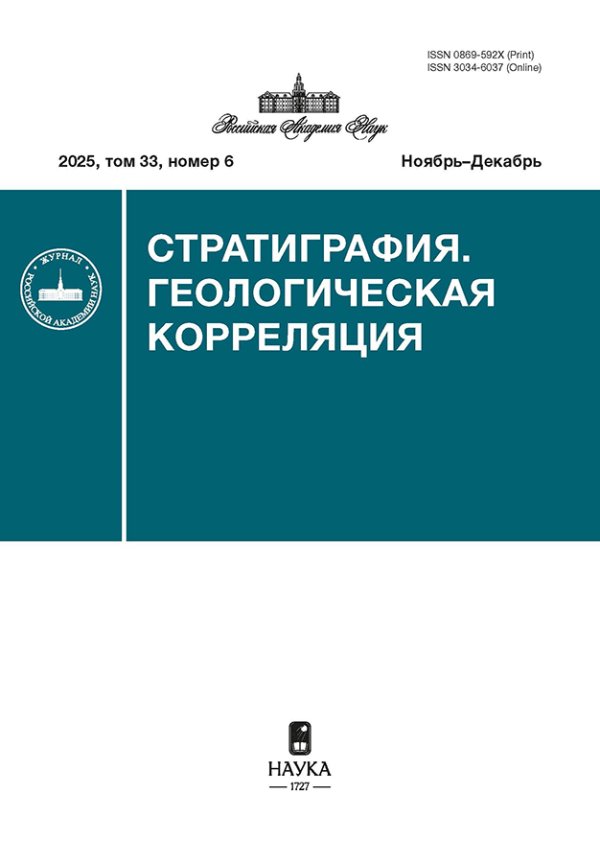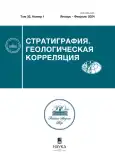Vol 32, No 1 (2024)
Polymetamorphism in the Geological Development of the South Altai Metamorphic Belt, Central Asian Folded Belt
Abstract
The crystal complexes of the Hercynian South Altai Metamorphic Belt (SAMP), which is a part of the Central Asian Folded Belt, with a length of more than 1500 km, compose tectonic plates of different scales, in which the level of metamorphism in the early stages reached the conditions of high-temperature subfacies of amphibolite and, in places, granulite facies. In tectonic terms, the band of their exits is confined to the outskirts of the North Asian Caledonian continent, stretching from southeast to northwest along the southern slope of the Gobi, Mongolian and Chinese Altai to Eastern Kazakhstan, where they are represented in the Irtysh shear zone. Poly- and monometamorphic complexes have been established as a part of the SAMP. The age of granitoids of the late episode of metamorphism was determined for the Tsel tectonic plate of the Gobi Altai in the southeastern part of the SAMP: from 374 ± 2 to 360 ± 5 million years. These and previously obtained results show that the early episode of low-pressure metamorphism and the late episode of high-pressure metamorphism occurred in the intervals of ~390–385 and 375–360 MA, respectively, almost throughout this belt. In the interval between them, a short-term stabilization stage is fixed. These processes occurred during the closure of the basin with the oceanic crust of the Tethys series of the South Mongolian Ocean (Paleothesis I). The spatial position of the SAMP is due to the asymmetry of the structure of the basin, in which the active continental margin is represented along its northern part, and the passive one along the southern (in modern coordinates).
 3-18
3-18


The Middle-Upper Jurassic Boundary in the North of Siberia: Problems of the Evidence
Abstract
The evidence for identifying the Eboraciceras subordinarium Zone in Siberian upper Callovian are discussed. Main outcrops with ammonite assemblages are studied in details. It is concluded that Subordinarium Zone is invalid and cannot be used in stratigraphic schema further. Beds with Cadoquenstedtoceras begichevi are proposed instead of Subordinarium Zone in the upper Callovian of Siberia.
 19-31
19-31


Structure, Age, and Evolution of the Late Mesozoic East Mongolian Volcanic Belt
Abstract
Geochronological studies of volcanic rocks ascribed to the Late Mesozoic East Mongolian volcanic belt (EMVB) allow to distinguish several groups among them that differ in age and composition of igneous associations, as well as in the features of their distribution within the region. The earliest group (about 215 Ma) is represented by rocks of the bimodal association distributed in the western part of the EMVB. The next group (170–150 Ma) is predominantly formed by felsic lavas of the shoshonitic–latite association, which compose large volcanic fields in the eastern part of the EMVB. The rocks with an age of 140–105 Ma form the EMVB cover and are predominantly represented by trachyandesite basalts, whose fields are accompanied by small volcanoes of trachydacites and trachyrhyolites. Separate groups of extrusions of alkaline basaltoids were formed in the interval of 105–80 Ma.
The rocks of different age associations are characterized by different geological position. The age and composition of the Late Triassic bimodal complex are compared with similar associations developed in central Mongolia and Western Transbaikalia framing the Khentey-Daur batholith. Their formation is associated with the evolution of the Early Mesozoic Khentey-Daur zonal magmatic area. Middle–Late Jurassic igneous complexes are distributed mainly in the eastern part of the EMVB. The fields of their outcrops fit into the distribution zone of the Late Jurassic volcanic fields of the Great Xing’an volcanic belt, with which they are close both in the formation time and composition of volcanic associations. Cretaceous magmatism determined the main history of the formation of the EMVB. Its development was accompanied by rifting of numerous depressions and grabens, as well as the regular evolution of its mantle sources, directed towards an increase in the proportion of the intraplate component.
The dimensions, boundaries, and characteristics of the EMVB magmatism have been refined. The western boundary of the region is displaced to the east and is determined by a NW-trending end fault system that controls a chain of Early Cretaceous granite massifs, as well as rocks of the Late Cretaceous extrusive complex. The eastern boundary of the region is shifted to the west, where it coincides with the area of development of the rocks of the Early Cretaceous extrusive complex. Taking into account the data on the foreign position of the Late Triassic and Middle–Late Jurassic complexes in the structure of the EMVB, it has been established that the composition of the magmatic products of the belt is mainly determined by basic volcanic rocks. This is consistent with the idea that the EMVB is similar to other Late Mesozoic volcanic areas of the inland part of East Asia, in whose structure the proportion of felsic igneous rocks is subordinate.
 32-57
32-57


Bio-Magnetostratigraphy of the Turonian–Coniacian Deposits of the Lower Bannovka Section, South-East of the Russian Plate
Abstract
The lithological, paleontological and biostratigraphic characteristics of the Turonian–Coniacian deposits of the Lower Bannovka section, the stratotype of the Bannovka Formation (Volga region, Turonian) are presented. Magnetostratigraphic characteristics of thе sediments have been supplemented and elaborated. The petromagnetic data contribute to additional division of the section and to revealing the sedimentation rhythmicity. Paleomagnetic data combined with benthic foraminifera data contribute to the most detailed correlation of the Turonian–Coniacian deposits in the Volga region. The special aspects of the Gubkinsky horizon spreading have been indicated by the discussed sediments interval integrated studying results. It is explained by the existed region structural plan and by the processes preliminary to the Coniacian and Santonian sedimentation.
 58-90
58-90


Regional Paleogene Stratigraphic Scheme of Kaliningrad Oblast: State of the Art, Problems and Perspectives for Improvement
Abstract
The article discusses the current state of knowledge of the Paleogene stratigraphy of the Kaliningrad Oblast, discusses the age of local stratigraphic units and the volume of possible breaks in sedimentation, and sets trends for future regional studies of the Paleogene. The Paleocene Chistoozerskaya and Lubava formations both probably correspond to the Danian–Selandian by the foraminifer data, but their relationship is not definitely clear. The Zaostrovskaya Formation is suggested to be corresponding to the upper Thanetian, but its paleontological characteristics are very poor. The Sambian Formation corresponds to the Ypresian by foraminifers, but its exact stratigraphical interval is still not clear enough. The Alka Formation is presumably dated by the late Lutetian–early Bartonian. An updated after dinocyst study age of the Prussian Formation denotes early–late Priabonian. The newly deined by dinocyst study age of the Palvé Formation falls to the latest Priabonian. The Kurshskaya Formation corresponds to the uppermost Eocene– Oligocene–?lower Miocene. The problem of the presence and duration of hiatuses between formations remains relevant.
 91-117
91-117












